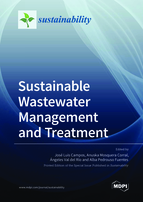Sustainable Wastewater Management and Treatment
A special issue of Sustainability (ISSN 2071-1050). This special issue belongs to the section "Sustainable Engineering and Science".
Deadline for manuscript submissions: closed (30 November 2021) | Viewed by 28215
Special Issue Editors
Interests: wastewater treatment; nutrient recovery; annamox
Interests: biological wastewater treatment processes: COD and nutrient removal from urban and industrial wastewater, aerobic granulation in sequential batch reactors, and anaerobic ammonia oxidation (Anammox) process; microscopy techniques: fluorescent in situ hybridization (FISH)
Interests: wastewater treatment; biological processes; aerobic granular sludge technology; partial nitritation and anammox processes for nitrogen removal; anaerobic digestion for sludge management; chemometric image analysis; disinfection by UV
Special Issues, Collections and Topics in MDPI journals
Interests: advanced wastewater treatment; biological processes; nitritation; anammox; autotrophic nitrogen removal; biological nitrogen and phosphorus removal; membrane filtration; granular biomass; organic matter valorization as VFA; decentralized wastewater systems
Special Issue Information
Dear Colleagues,
Although the original goal of wastewater treatment plants (WWTPs) was to remove pollutants from human and industrial effluents to protect both human health and ecosystems, new challenges are under consideration today, oriented at assuring the sustainability of WWTPs in terms of both reducing their environmental impact and integrating them into the urban circular economy. For these reasons, on one hand, energy consumption and greenhouse gases emissions are among the aspects that should become key factors concerning the overall performance of WWTPs. On the other hand, wastewater should be considered a valuable resource from which energy, clean water, nutrients, and value-added products can be extracted or produced to close material cycles.
To achieve these future goals, not only the development of new technologies and processes is necessary, but also a paradigm shift in wastewater management. In this sense, separation of different domestic wastewater streams and decentralization of wastewater treatment are recognized as the most promising concepts to promote local recycling and reuse of resources contained in domestic wastewater.
This Special Issue of Sustainability aims to report the latest developments in sustainable wastewater management and treatment. For this reason, we invite authors to contribute original research articles as well as review articles that will show the recent advances in this field.
Prof. Dr. José Luis Campos
Prof. Dr. Anuska Mosquera Corral
Prof. Dr. Ángeles Val del Río
Dr. Alba Pedrouso Fuentes
Guest Editors
Manuscript Submission Information
Manuscripts should be submitted online at www.mdpi.com by registering and logging in to this website. Once you are registered, click here to go to the submission form. Manuscripts can be submitted until the deadline. All submissions that pass pre-check are peer-reviewed. Accepted papers will be published continuously in the journal (as soon as accepted) and will be listed together on the special issue website. Research articles, review articles as well as short communications are invited. For planned papers, a title and short abstract (about 100 words) can be sent to the Editorial Office for announcement on this website.
Submitted manuscripts should not have been published previously, nor be under consideration for publication elsewhere (except conference proceedings papers). All manuscripts are thoroughly refereed through a single-blind peer-review process. A guide for authors and other relevant information for submission of manuscripts is available on the Instructions for Authors page. Sustainability is an international peer-reviewed open access semimonthly journal published by MDPI.
Please visit the Instructions for Authors page before submitting a manuscript. The Article Processing Charge (APC) for publication in this open access journal is 2400 CHF (Swiss Francs). Submitted papers should be well formatted and use good English. Authors may use MDPI's English editing service prior to publication or during author revisions.
Keywords
- circular approach
- decentralized treatment systems
- economic assessment
- energy approach
- greenhouse gas emissions
- life cycle assessment
- microbiology
- micropollutants
- municipal and industrial wastewater treatment
- nutrient recovery
- simulation and optimization
- sludge management
- source separation
- value-added products
- water reuse









